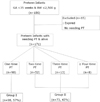Abstract
Objectives
Clinical features according to the frequency of phototherapy and clinical risk factors on the number of phototherapy were investigated in premature births with gestation <35 weeks and birth weight ≤2,500 g.
Methods
The 186 infants with gestation <35 weeks and birth weight ≤2,500 g were admitted to the neonatal intensive care unit of Kosin University Gospel Hospital from March 2009 to August 2010. The 171 infants were alive and had jaundice requiring phototherapy. Phototherapy was usually started to 50-70% of the maximal bilirubin level. They were divided into two groups according to the frequency of phototherapy as single phototherapy group (group I) and multiple phototherapy group (group II). We retrospectively reviewed the medical records of all patients.
Results
The mean gestational age and birth weight of group I were 31.0±2.9 weeks and 1,596±485 g and those of group II were 31.1±2.6 weeks and 1,592±430 g. Compared with group I, albumin and Apgar score at 1 minute of group II were significantly higher and the day of peak bilirubin was also late. Duration of phototherapy in group II was statistically longer than that group I but duration of ventilator and aminophylline use for apnea was significantly shorter. The frequency of antibiotic use, incidence of bronchopulmonary dysplasia (BPD), and intraventricular hemorrhage (IVH) of group II were significantly lower than those of group I.
Figures and Tables
Fig. 1
Summary of preterm infants by the frequency of phototherapy
Abbreviations: GA, Gestational age; BW, Birth weight; PT, Phototherapy

References
1. American Academy of Pediatrics Subcommittee on Hyperbilirubinemia. Management of hyperbilirubinemia in the newborn infant 35 or more weeks of gestation. Pediatrics. 2004. 114:297–316.
2. Kliegman RM. Kliegman RM, Stanton RM, St. Geme JW, Schor NF, Behrman RE, editors. Jaundice and hyperbilirubinemia in the newborn. Nelson Textbook of Pediatrics. 2011. 19th ed. Philadelphia: WB Saunders Co;603–608.
3. de Almeida MF. When should we start phototherapy in preterm newborn infant? J Pediatr (Rio J). 2004. 80:256–258.
4. Benders MJ, van Bel F, van de Bor M. The effect of phototherapy on renal blood flow velocity in preterm infants. Biol Neonate. 1998. 73:228–234.

5. Mesner O, Miller MJ, Iben SC, Prabha KC, Mayer CA, Haxhiu MA, et al. Hyperbilirubinemia diminishes respiratory drive in a rat pup model. Pediatr Res. 2008. 64:270–274.

6. Choi CW, Min KW, Kim MN, Hwang JH, Shim JW, Koh SY, et al. Bilirubin cytotoxicity in primary mouse cerebral cortical cell culture. J Korean Soc Neonatol. 2003. 10:241–247.
7. Choi CW, Hwang JH, Kang S, Shim JW, Chung SH, Koh SY, et al. Effect of hyperbilirubinemia on the brainstem auditory evoked response in newborn piglets. J Korean Soc Neonatol. 2003. 10:248–253.
8. O'Shea TM, Dillard RG, Klinepeter KL, Goldstein DJ. Serum bilirubin levels, intracranial hemorrhage, and the risk of developmental problems in very low birth weight neonates. Pediatrics. 1992. 90:888–892.
9. Maisels MJ. Phototherapy--traditional and nontraditional. J Perinatol. 2001. 21:Suppl 1. S93. S97. discussion S104-7.
10. Maisels MJ, Watchko JF. Treatment of jaundice in low birthweight infants. Arch Dis Child Fetal Neonatal Ed. 2003. 88:F459–F463.

11. DeJonge MH, Khuntia A, Maisels MJ, Bandagi A. Bilirubin levels and severe retinopathy of prematurity in 23-26 week estimated gestational age infants. J Pediatr. 1999. 135:102–104.

13. Dani C, Martelli E, Bertini G, Pezzati M, Filippi L, Rossetti M, et al. Plasma bilirubin level and oxidative stress in preterm infants. Arch Dis Child Fetal Neonatal Ed. 2003. 88:F119–F123.

14. Hegyi T, Goldie E, Hiatt M. The protective role of bilirubin in oxygen-radical diseases of the preterm infant. J Perinatol. 1994. 14:296–300.
15. Gopinathan V, Miller NJ, Milner AD, Rice-Evans CA. Bilirubin and ascorbate antioxidant activity in neonatal plasma. FEBS Lett. 1994. 349:197–200.

16. Rosenfeld W, Sadhev S, Brunot V, Jhaveri R, Zabaleta I, Evans HE. Phototherapy effect of the incidence of patent ductus arteriosus in premature infants: prevention with chest shielding. Pediatrics. 1986. 78:10–14.

17. Barefield ES, Dwyer MD, Cassady G. Association of patent ductus arteriosus and phototherapy in infants weighing less than 1000 grams. J Perinatol. 1993. 13:376–380.




 PDF
PDF ePub
ePub Citation
Citation Print
Print






 XML Download
XML Download